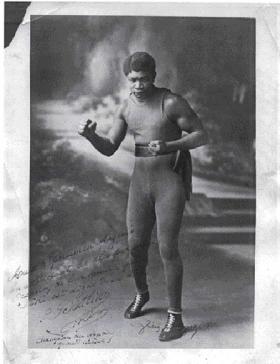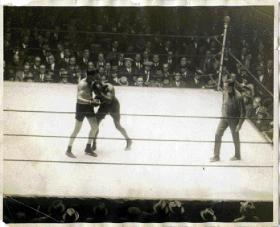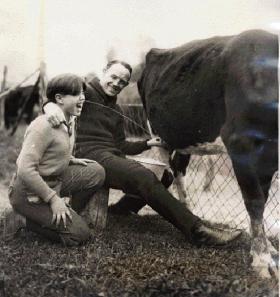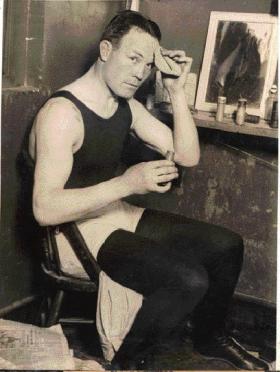TV Eye
Published in 20th-century / Contemporary History, Issue 2 (Mar/Apr 2008), Reviews, Volume 16
Light heavyweight champion Louis M’Barick Fall from Senegal, a.k.a. ‘Battling Siki’. He later succumbed to alcoholism before being murdered in New York in 1925.
Troid Fhuilteach
TG4, 16 January 2008
Fastnet Films
by John Gibney
Boxing’s profile has declined in Ireland. Although the occasional high-profile bout will attract attention (Hatton v. Mayweather last December, for example) or a new contender capture the imagination (Bernard Dunne—at least before he got battered last August), the sport no longer occupies the space in the public eye that it once did. But it was one of the great spectator sports of the twentieth century. Troid Fhuilteach told the remarkable story of a fight that took place in Dublin on St Patrick’s Day 1923, when a world light heavyweight title was decided against the backdrop of the Irish Civil War.
The two contenders were Mike McTigue of Clare and Louis M’Barick Fall of Senegal, a.k.a. ‘Battling Siki’. McTigue was a stonemason’s son, born, as he once quipped, ‘just outside the money’. It was almost certainly a sardonic comment. In the years before the First World War rural Clare was a poor and impoverished county, with high levels of emigration. In 1912 McTigue trod a well-worn path and left Cobh for New York, joining his brother in the Bronx and working in the meat-packing industry. He quite literally began his boxing career on the factory floor, where his talent was spotted and he was propelled into a moderately successful boxing career in New York. But a major title bout proved elusive, and he returned to Ireland in June 1922, on the eve of the outbreak of civil war.

McTigue and Siki in action in the La Scala Theatre, Dublin, on St Patrick’s Day 1923.
Before the end of the war McTigue would finally get the proverbial shot at the title. The man that he would fight was, like McTigue, essentially a tough journeyman.
Battling Siki had left Senegal thanks to a French woman who, having failed in an attempted adoption, abandoned him in Marseilles. Forced to make his own way in the world, he did so as a fighter. An unremarkable early career was interrupted by the First World War. Siki enlisted in the French army and was decorated for bravery, and resumed his boxing career after the war with much greater success. As a black
African, however, Siki was subject to appalling racism in France: comparisons with baboons were made in the French press. Having been paired off in a rigged bout in September 1922 with the French world light heavyweight champion, Georges Carpentier, Siki fought back and beat Carpentier in front of 55,000 spectators. The planned result was upheld by Siki’s disqualification on a technicality, but it was later overturned. Siki was the first African world champion, and he made a point of flaunting his new status.

McTigue shares a lighter moment with a young fan after the fight. He would subsequently ‘milk’ his world title in a lucrative boxing career in the US, though his fortune was wiped out in the Wall Street Crash in 1929.
(All images: Fasnet Films)
There were echoes of the challenge thrown down to the white boxing establishment in the US by Jack Johnson, and Siki would not be permitted to emulate him. He was
unable to get another fight in Europe, even being banned from entering Britain. The only country in which Siki was able to defend his title was the newly formed Irish Free State. His opponent would be McTigue.
The bout was seized upon by opportunistic promoters and was also favoured by the Free State government. As they prosecuted the Civil War to a bitter end, the staging of a sporting event of this stature would prove to the world that Ireland was back to normal after years of upheaval. It also suited McTigue. America was the real land of opportunity for an Irish boxer, and a fight of this kind was the perfect way to re-establish his credentials in order to engineer a return.
Siki was less enthusiastic, but this fight was the only option left to him: he had not even received the purse from his fight with Carpentier. The match attracted considerable attention. Over 100 journalists arrived in Ireland to cover it, and it was scheduled to take place in Dublin’s La Scala Theatre on 17 March 1923. But just as the Free State authorities sought to take political advantage of the high profile of the contest, the IRA was intent on disrupting it to illustrate to the world that it was still at war: both sides in the conflict had contrasting stakes in it. Added impetus was given by the execution of three republican prisoners in the week before the fight. The IRA decreed that no sporting events should take place as a mark of respect, and both fighters were escorted to the venue by Free State troops.

The challenger, Mike McTigue, a stonemason’s son from County Clare, born ‘just outside the money’.
There was even a bomb scare, but the fight went ahead: the last twenty-round world title fight ever staged. Despite his opening barrage, Siki was worn down over the course of it by McTigue’s ferocity—he dislocated a thumb on Siki’s head—and after a close fight the referee’s decision went to McTigue. From the point of view of the institutionally racist boxing authorities of the day, normal service had been resumed.
The careers of both men were defined by the bout. McTigue returned to the US. With the added cachet of a world title, boxing made him a rich man, though his fortune was wiped out in the Wall Street Crash of 1929 and he was forced, ignominiously, to return to the ring. But Siki never even had that opportunity. A defeated black former champion, he eked out a living in New York, descending into alcoholism before being murdered there in 1925. The story of these two men and their single encounter is perhaps a minor footnote to history, but it is a fascinating human drama, illuminated here by an extraordinary array of contemporary footage, up to and including the fight itself. Numerous threads intersected in the event: international sport, Irish politics, and the careers of two men whose vastly different origins hide the fact that they probably had more in common with one another than they ever realised. But their meeting was, first and foremost, a product of the vicious racism that infected Europe as much as America in the early twentieth century. This fascinating documentary, originally made in Irish and broadcast on TG4, is being re-edited in a longer English-language version that should receive its première at the Cork Film Festival. It is a story well worth telling in any language.
John Gibney is an IRCHSS Government of Ireland fellow at the Moore Institute for Research in the Humanities and Social Studies, NUI Galway.
















